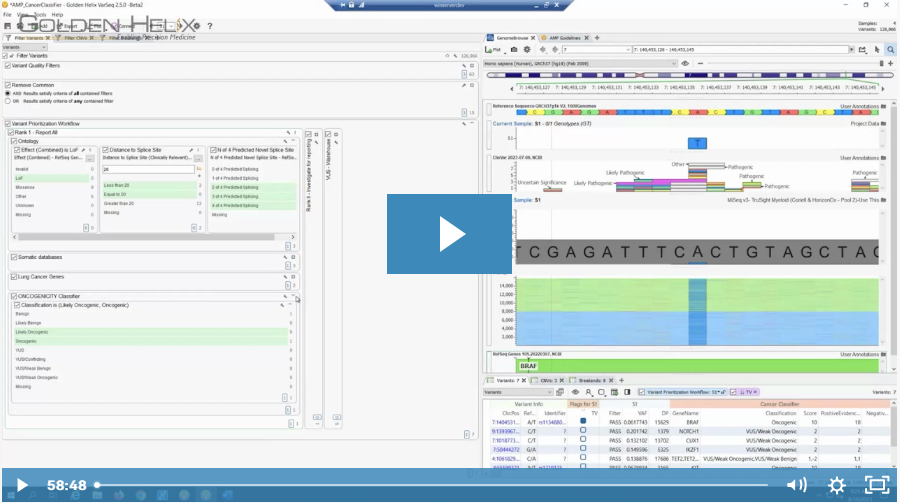
With the widespread adoption of next-generation sequencing for clinical and research applications comes the need for guidance and recommended standards and best practices for achieving accuracy and efficacy for each assay pipeline. The support team at Golden Helix has gotten a lot of hands-on experience in assisting users to build their bioinformatics workflows for NGS assays. We recently shared our insights into the best practices we have observed for validating an NGS workflow in our latest webcast. This blog serves to highlight the main topics covered in the webcast by members of the Field Application Science team, Dr. Rana Smalling and Director Darby Kammeraad.
Early considerations
Prior to any workflow construction, there are several beneficial planning and organization steps a user can take. These mainly involve the establishment of appropriate controls and setting an early framework for the desired outputs of the NGS workflow. We discussed two types of controls. Generic samples that are publicly available such as the Horizon Molecular reference standards, are useful for testing the accuracy of a secondary pipeline, the accuracy of variant classification, and for benchmarking purposes. These types of controls are insightful but not intended for the ultimate validation of a clinical variant filtration strategy for routine diagnostics. For this purpose, the more appropriate controls would be actual test cases with established results from your own pipeline.
It will also be important to determine early on the number of samples that will give enough power to your study and establish statistical robustness, as this will enable you to accurately estimate the cost of your intended projects. Luckily, VarSeq is agnostic to the secondary pipeline used and sample type such as blood, tumor, FFPE, etc. Moreover, our subscription model allows you to process multiple samples without increasing your cost for reanalysis.
The other early consideration is defining the ultimate scope of the evaluation and the desired output for a report, as this will influence the entire workflow design. For example, in a somatic workflow are you interested in reporting copy number variants and fusions or small variants only, or are you focused on primary findings i.e. tumor biomarkers only or will you include secondary germline findings?
Optimal NGS Workflow
The main aspect that streamlines workflow validation in VarSeq is the ability to develop the ideal filtering template that can be used routinely across all samples. We covered some filtering recommendations that are common to most workflows but modifiable for specific use cases. We touched on filter parameters for a workflow design that is efficacious enough to capture the most impactful and relevant variants while removing uninteresting or benign variants. Some of these parameters including quality and frequency thresholds for identifying high-quality and rare variants. We gave brief insights on the commonly used thresholds for variant allele fraction (VAF) and population allele frequency as suggested in the ACMG guidelines. The discussion on workflow design also included some pro tips, including leveraging sample-specific considerations such as family relationships and unique phenotypes and validation tools such as our variant tracking flag system.
Example validation process
For the software demonstration, we wanted to share some real-world examples of validation workflows. These were based on insights gained from working with multiple customers in different fields and with varying levels of clinical involvement. We covered some examples for both somatic and germline workflows to demonstrate optimal filtering strategies and validation tips, such as how to track and investigate a variant(s) expected to be detected in a control sample, direct to report versus an “ultimate VUS” reevaluation pipeline in somatic contexts, statistical review and quality control for copy number variant detection and customizing the final clinical report. You can catch the details of these examples by reviewing our webcast.
We wanted to offer these insights as a high-level overview of the process of validating an NGS workflow, and we invite further discussion from users performing NGS in the cancer and germline contexts. Overall, VarSeq’s transparency, customizability, resourceful features, and involved support allow users to create robust workflows that fit a range of requirements and incorporate variant interpretation guidelines, such as the ACMG/ACGS and AMP guidelines. Please feel free to contact us at [email protected] with any questions, comments, or concerns regarding this topic.